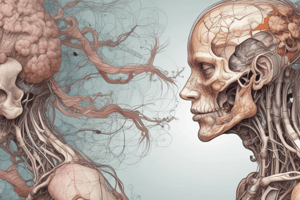Podcast
Questions and Answers
What is the function of the optic nerve in the visual pathway?
What is the function of the optic nerve in the visual pathway?
- To produce tears to lubricate the eye
- To regulate the amount of light that enters the eye
- To transmit auditory information from the ear to the brain
- To transmit visual information from the eye to the brain (correct)
Which of the following types of cones is sensitive to low-intensity light?
Which of the following types of cones is sensitive to low-intensity light?
- Long-wavelength cones
- Rod cells (correct)
- Medium-wavelength cones
- Short-wavelength cones
What is the name of the structure that separates the middle ear from the inner ear?
What is the name of the structure that separates the middle ear from the inner ear?
- Tympanic membrane
- Eustachian tube
- Cochlea
- Oval window (correct)
Which of the following organs is responsible for maintaining equilibrium and balance?
Which of the following organs is responsible for maintaining equilibrium and balance?
What is the name of the sensory pathway that transmits taste information from the tongue to the brain?
What is the name of the sensory pathway that transmits taste information from the tongue to the brain?
Which type of photoreceptor is responsible for peripheral and night vision?
Which type of photoreceptor is responsible for peripheral and night vision?
Which of the following is NOT a characteristic of the auditory nerve?
Which of the following is NOT a characteristic of the auditory nerve?
What is the function of the vestibular apparatus in the inner ear?
What is the function of the vestibular apparatus in the inner ear?
Which of the following cranial nerves is responsible for transmitting taste information from the tongue?
Which of the following cranial nerves is responsible for transmitting taste information from the tongue?
What is the term for the ability of the eye to focus on objects at different distances?
What is the term for the ability of the eye to focus on objects at different distances?
Flashcards are hidden until you start studying
Study Notes
The Special Senses
- The special senses include vision, hearing, taste, smell, and equilibrium (balance), which are responsible for detecting and interpreting various stimuli from the environment.
- The special senses are mediated by sensory receptors that are sensitive to specific stimuli and transmit signals to the brain for interpretation.
Vision
- The eye is the organ of vision, and it consists of the cornea, iris, lens, retina, and optic nerve.
- Light enters the eye through the cornea, pupil, and lens, and is focused on the retina, where it is converted into electrical signals by photoreceptors (rods and cones).
- The optic nerve transmits these signals to the brain, where they are interpreted as visual information.
- The visual pathway involves the transmission of signals from the retina to the lateral geniculate nucleus, and then to the primary visual cortex for processing.
Hearing
- The ear is the organ of hearing, and it consists of the outer ear, middle ear, and inner ear.
- Sound waves enter the outer ear and travel through the middle ear, causing the eardrum to vibrate, which transmits the vibrations to the inner ear through the ossicles.
- The cochlea in the inner ear converts the vibrations into electrical signals, which are transmitted to the brain through the auditory nerve.
- The auditory pathway involves the transmission of signals from the cochlea to the cochlear nuclei, and then to the auditory cortex for processing.
Taste
- Taste is mediated by taste buds on the tongue and elsewhere in the oral cavity, which contain specialized receptors for sweet, sour, salty, bitter, and umami tastes.
- Chemicals in food and drink come into contact with the taste receptors, triggering electrical signals that are transmitted to the brain through the chorda tympani and glossopharyngeal nerves.
- The taste pathway involves the transmission of signals from the taste buds to the solitary nucleus, and then to the insular cortex for processing.
Smell
- Smell is mediated by olfactory receptors in the nasal mucosa, which are sensitive to odor molecules in the air.
- When odor molecules bind to the olfactory receptors, they trigger electrical signals that are transmitted to the brain through the olfactory nerve.
- The olfactory pathway involves the transmission of signals from the olfactory receptors to the olfactory bulb, and then to the piriform cortex for processing.
Equilibrium
- Equilibrium is mediated by the vestibular system in the inner ear, which consists of the otolith organs and semicircular canals.
- The vestibular system detects changes in head position and movement, and transmits signals to the brain through the vestibular nerve.
- The equilibrium pathway involves the transmission of signals from the vestibular system to the vestibular nuclei, and then to the cerebellum and other areas for processing and integration with other senses.
Studying That Suits You
Use AI to generate personalized quizzes and flashcards to suit your learning preferences.





